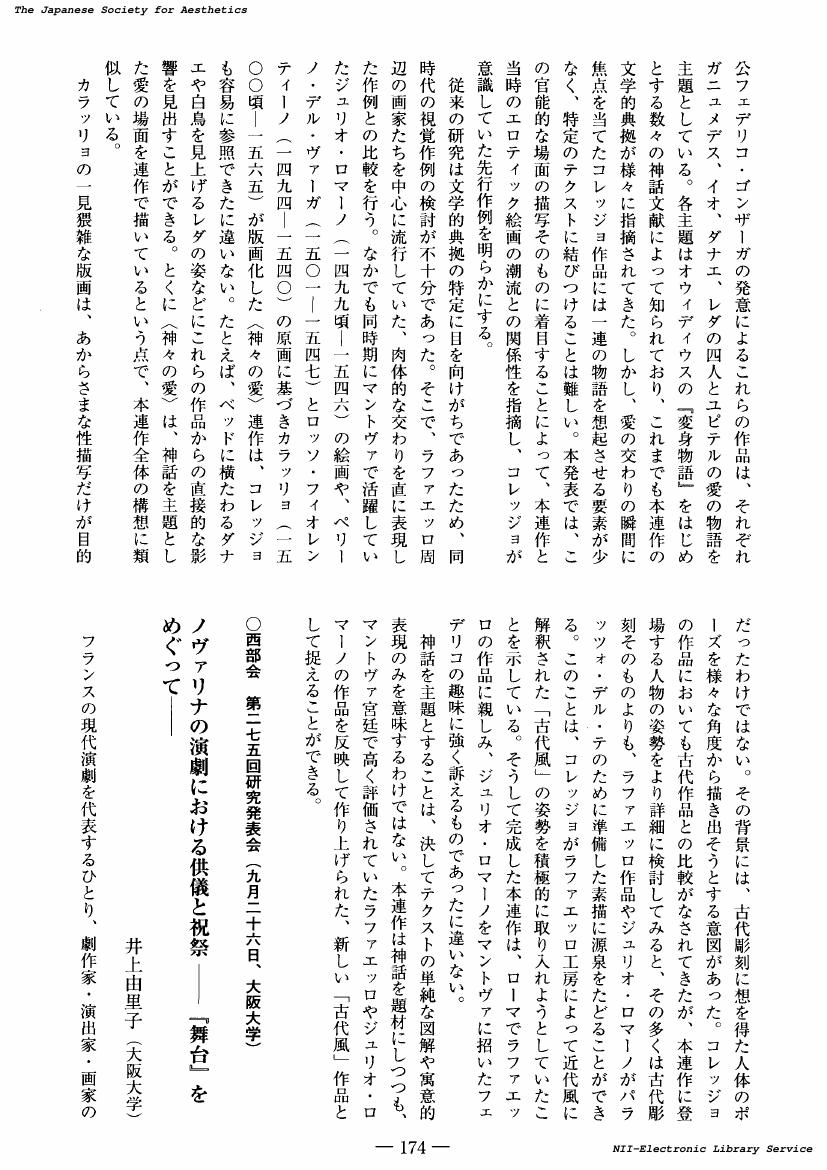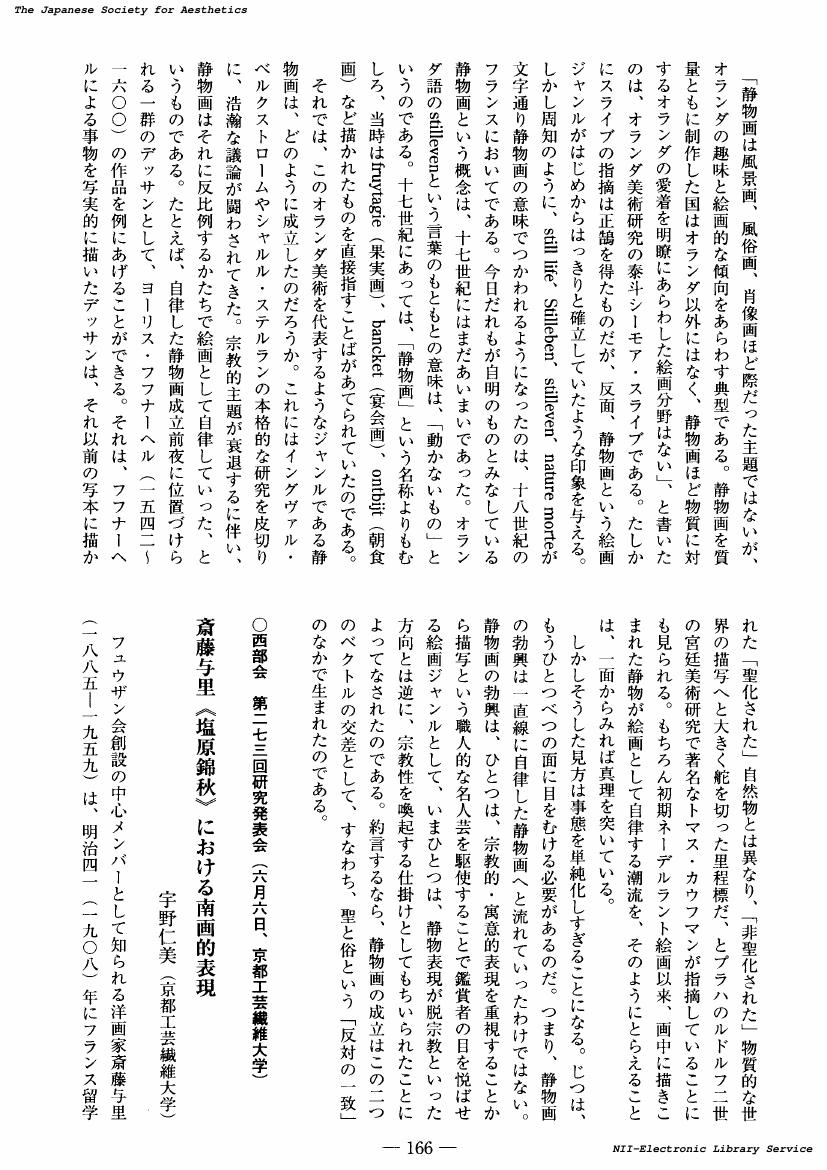1 0 0 0 OA 感性的質の生成構造、または感性史の試み
- 著者
- 津上 英輔
- 出版者
- 美学会
- 雑誌
- 美学 (ISSN:05200962)
- 巻号頁・発行日
- vol.61, no.1, pp.1-12, 2010-06-30 (Released:2017-05-22)
Sibley observed in "Aesthetic Concepts" that "many words have come to be aesthetic terms by some kind of metaphorical transference", though without specifying what kind. In the transference of e.g. "nostalgic" from its primary sense as having nostalgia (He was^1 nostalgic.) to its metaphorical, aesthetic sense as causing nostalgia (The song was^2 nostalgic.), a thing takes the place of a person as the subject. This process contains a reciprocal alternation (a) from an objective viewpoint (was^1) to a subjective and again (b) to an objective (was^2). I argue one bridge connecting both ends is the subjective verb feel, with its active (He felt nostalgic. =a) and quasi-passive use with a thing as the subject (The song felt nostalgic. =b). This theory enables us to trace the history of our sensibility by pursuing grammatical or lexical changes particular words underwent over a period. One example is a group of terms denoting mental diseases including "nostalgia". Most of them have positive aesthetic meanings. This illustrates our sensibility's tendency to approve of what is socially or morally repudiated. Since we are capable of dating the changes using the OED, such individual observations will add up to a history of our aesthetic sensibility.
- 著者
- 星野 太
- 出版者
- 美学会
- 雑誌
- 美学 (ISSN:05200962)
- 巻号頁・発行日
- vol.61, no.1, pp.13-24, 2010-06-30 (Released:2017-05-22)
In this paper, I examine Edmund Burke's A Philosophical Enquiry into the Origin of Our Ideas of the Sublime and Beautiful (1757/59), comparing it with Pseudo-Longinus' On the Sublime. In his book, Burke does not refer to On the Sublime but once, although he shares one of the main subjects with Pseudo-Longinus, namely the "Sublime". However, in the Part V of Sublime and Beautiful, one can find some descriptions where the tradition of rhetoric, including On the Sublime, is recognized. Especially, Burkian notion of "Passion", which is discussed at the last part of Sublime and Beautiful, draws a lot of attention. According to Burke, arousing the "sympathy" or "contagion of our passion" is made possible only by words, not by paintings, architectures, or natural objects. And he assumes that the sympathy is aroused by words without "picture" (namely, mental representation). This is the very reason why, I suppose, Burke excludes Pseudo-Longinus' theory from his book on the "Sublime and Beautiful". For Pseudo-Longinus assumes that, when the violent power of speech arouses a sympathy, it is mediated as vivid image (phantasia). To put it briefly, while Pseudo-Longinus considers that the mental representation is necessary to influence other's passion by words, Burke takes the standpoint contrast with that of Pseudo-Longinus.
- 著者
- 田中(鈴木) 裕子
- 出版者
- 美学会
- 雑誌
- 美学 (ISSN:05200962)
- 巻号頁・発行日
- vol.61, no.1, pp.37-48, 2010-06-30 (Released:2017-05-22)
Denis Diderot examined the notation of the cylinders that were used in barrel organs and explored the possibilities of these instruments in his 'Quatrieme Memoire-Projet d'un nouvel orgue' <<Memoires sur differents sujets de mathematiques>> (1748). His Projet was not regarded as being particularly important at the time and his suggestions were probably never put into practice; they might be dismissed as just another technical proposal in the long history of automatic musical instruments. However, the Projet is important as a documentation of Diderot's attitude towards music and musicians. Diderot criticized those musicians who were satisfied with the status quo and pointed out the advantages of developing automatic instruments which they might have perceived as a threat. On the other hand, he insisted that musicians should not be required to keep rigidly accurate time like a machine or chronometre. Although we see that an analogy is being drawn between musicians and machines, it is clear that he did not believe that one was a substitute for the other. Studying his text, we see that he neither rejected machines nor regarded them with blind admiration.
- 著者
- 小宮山 晶子
- 出版者
- 美学会
- 雑誌
- 美学 (ISSN:05200962)
- 巻号頁・発行日
- vol.61, no.1, pp.49-60, 2010-06-30 (Released:2017-05-22)
In diesem Aufsatz wird versucht, die Wandlungen der musikalischen Hauptmotive im Ring zu uberdenken, um das Grundthema der Tetralogie und seine Entwicklungen von seiten der Musik zu erhellen. Die Rhein-Motive zu Beginn Des Rheingoldes (Naturmotive, Rheintochtergesang, usw.) gelten als musikalische Sinnbilder der "Natur", so dass man oft versucht, auch ihre Varianten unter diesem Aspekt zu interpretieren. Die Grundbedeutung der "Natur" lasst sich jedoch so zusammenfassen, dass das Rheingold tief im Rhein gehutet wird, ohne irgendeinem anzugehoren. In der Erda-Szene weist die Moll-Variante des Naturmotivs darauf hin, dass der Ring nicht Wotan gehore, sondern dem Rhein. In der Nibelheim-Szene und "Hagens Wachtgesang" verdammt das stark dissonierende Rheintochterthema, die Besitzgier von Alberich und Hagen. Ausserdem singt der Waldvogel eine rhythmische Variante des Rheintochtergesangs, denn seine Pflicht ist es, das Gold dem Rhein zuruckzugeben, und somit den Urzustand der "Natur" wiederherzustellen. Darum bewegt er Siegfried dazu, dem Wurm den Ring zu rauben. Nach der Dramaturgie, namlich "der Verstarkung der Motive" in Oper und Drama, hatte Wagner die Rhein-Motive und die Varianten mit mehreren Bedeutungen versehen. Daraufhin fasste er die Motivgruppe unter der Grundbedeutung der "Natur" zusammen, damit das ganze Drama durch die Rhein-Motive musikalisch und auch semantisch vereinheitlicht wird. Das entspricht "der einheitlichen kunstlichen Form", die er in Oper und Drama als die vollendetste Kunstform konzipiert hat.
1 0 0 0 OA ベルネー修道院教会 : 建設過程の再考
- 著者
- 愛宕 出
- 出版者
- 美学会
- 雑誌
- 美学 (ISSN:05200962)
- 巻号頁・発行日
- vol.61, no.1, pp.61-72, 2010-06-30 (Released:2017-05-22)
A la partie inferieure des piliers de la nef de Bernay, les bases des demi-colonnes se plaquent contre le cavet des noyaux rectangulaires. Ce phenomene est interprete comme le resultat d'un changement de parti. Mais nous supposons que cette partie a ete construite d'un seul travail. Dans le choeur, on trouve des piliers composes plus complexes que dans la nef, mais cette forme derive de l'intention d'enbellir le chceur par les chapiteaux sculptes, que, selon M. Bayle, les moines auraient travailles soi-memes. En effet, l'exemen de la partie inferieure des piliers du choeur confirme que l'atelier de macons a de la difficulte a s'adapter a cette forme complexe. L'anomalie des piliers de la nef resulte, d'autre part, de la simplification de travail en l'absence des moines. Cette simplification de forme vis-a-vis du choeur peut se trouver a d'autres exemples romans, mais le pragmatisme franc de l'atelier de macons serait l'un des particularites uniques de l'architecture normande.
- 著者
- 内野 博子
- 出版者
- 美学会
- 雑誌
- 美学 (ISSN:05200962)
- 巻号頁・発行日
- vol.60, no.2, pp.168-169, 2009-12-31 (Released:2017-05-22)
- 著者
- 長岡 龍作
- 出版者
- 美学会
- 雑誌
- 美学 (ISSN:05200962)
- 巻号頁・発行日
- vol.60, no.2, pp.169-170, 2009-12-31 (Released:2017-05-22)
- 著者
- 内田 次信
- 出版者
- 美学会
- 雑誌
- 美学 (ISSN:05200962)
- 巻号頁・発行日
- vol.60, no.2, pp.170-171, 2009-12-31 (Released:2017-05-22)
1 0 0 0 OA 琳派試論 : 琳派と能楽(西部会第二七四回研究発表会,例会・研究発表会要旨)
- 著者
- 榊原 吉郎
- 出版者
- 美学会
- 雑誌
- 美学 (ISSN:05200962)
- 巻号頁・発行日
- vol.60, no.2, pp.172, 2009-12-31 (Released:2017-05-22)
- 著者
- 辻 絵理子
- 出版者
- 美学会
- 雑誌
- 美学 (ISSN:05200962)
- 巻号頁・発行日
- vol.60, no.2, pp.172-173, 2009-12-31 (Released:2017-05-22)
- 著者
- 小松 健一郎
- 出版者
- 美学会
- 雑誌
- 美学 (ISSN:05200962)
- 巻号頁・発行日
- vol.60, no.2, pp.173-174, 2009-12-31 (Released:2017-05-22)
- 著者
- 井上 由里子
- 出版者
- 美学会
- 雑誌
- 美学 (ISSN:05200962)
- 巻号頁・発行日
- vol.60, no.2, pp.174-175, 2009-12-31 (Released:2017-05-22)
- 著者
- 三河 隆之
- 出版者
- 美学会
- 雑誌
- 美学 (ISSN:05200962)
- 巻号頁・発行日
- vol.60, no.2, pp.160, 2009-12-31 (Released:2017-05-22)
- 著者
- 山根 千明
- 出版者
- 美学会
- 雑誌
- 美学 (ISSN:05200962)
- 巻号頁・発行日
- vol.60, no.2, pp.161, 2009-12-31 (Released:2017-05-22)
- 著者
- 山本 佐恵
- 出版者
- 美学会
- 雑誌
- 美学 (ISSN:05200962)
- 巻号頁・発行日
- vol.60, no.2, pp.162, 2009-12-31 (Released:2017-05-22)
- 著者
- 和賀 圭史
- 出版者
- 美学会
- 雑誌
- 美学 (ISSN:05200962)
- 巻号頁・発行日
- vol.60, no.2, pp.164, 2009-12-31 (Released:2017-05-22)
- 著者
- 後藤 文子
- 出版者
- 美学会
- 雑誌
- 美学 (ISSN:05200962)
- 巻号頁・発行日
- vol.60, no.2, pp.165, 2009-12-31 (Released:2017-05-22)
- 著者
- 尾崎 彰宏
- 出版者
- 美学会
- 雑誌
- 美学 (ISSN:05200962)
- 巻号頁・発行日
- vol.60, no.2, pp.165-166, 2009-12-31 (Released:2017-05-22)
- 著者
- 宇野 仁美
- 出版者
- 美学会
- 雑誌
- 美学 (ISSN:05200962)
- 巻号頁・発行日
- vol.60, no.2, pp.166-167, 2009-12-31 (Released:2017-05-22)
1 0 0 0 OA 社会美について(西部会第二七三回研究発表会,例会・研究発表会要旨)
- 著者
- 宮原 浩二郎
- 出版者
- 美学会
- 雑誌
- 美学 (ISSN:05200962)
- 巻号頁・発行日
- vol.60, no.2, pp.167-168, 2009-12-31 (Released:2017-05-22)














